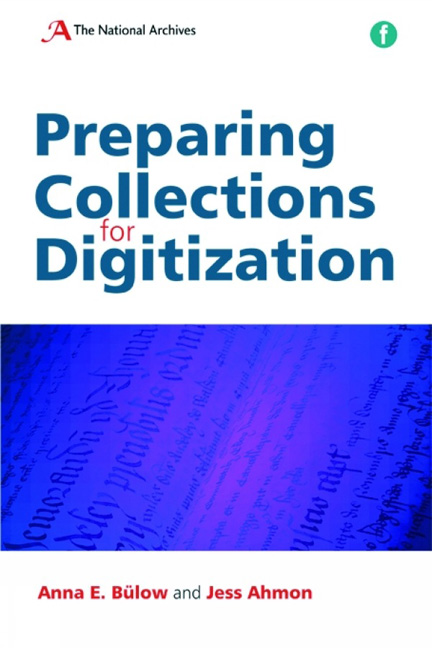Book contents
- Frontmatter
- Contents
- Acknowledgements
- List of figures and tables
- Introduction
- 1 Digitization in the context of collection management
- 2 Before you digitize: resources, suppliers and surrogates
- 3 The digital image Ross Spencer
- 4 The process of selection
- 5 Surveying collections
- 6 Equipment for image capture
- 7 Preparation of document formats and fastenings
- 8 Preparation of damaged documents
- 9 Setting up the imaging operation
- Conclusion
- Further reading
- Index
7 - Preparation of document formats and fastenings
Published online by Cambridge University Press: 08 June 2018
- Frontmatter
- Contents
- Acknowledgements
- List of figures and tables
- Introduction
- 1 Digitization in the context of collection management
- 2 Before you digitize: resources, suppliers and surrogates
- 3 The digital image Ross Spencer
- 4 The process of selection
- 5 Surveying collections
- 6 Equipment for image capture
- 7 Preparation of document formats and fastenings
- 8 Preparation of damaged documents
- 9 Setting up the imaging operation
- Conclusion
- Further reading
- Index
Summary
Introduction
As discussed in Chapter 6 ‘Equipment for image capture’ the physical attributes of a collection will influence the choice of equipment. However, even if the most suitable equipment has been selected many collections will still need to be prepared in some way before digitization. Preparation consists of dealing with any aspects of the document format and condition that will interfere with the image capture. It ensures that items are ready for imaging, can be safely handled and that good quality images are captured. Preparing documents for image capture will add to the timescale and budget of a project but with careful planning and good management it can be incorporated smoothly into the workflow of an operation and will help the project run more efficiently. If preparation is nonexistent, inadequate or poorly planned, this can result in repeated delays at the imaging stage and/or in a poor quality, incomplete digital surrogate.
This chapter looks at preparing different document formats and fastened documents while Chapter 8 ‘Preparation of damaged documents’ focuses on conservation work to deal with damaged documents. Although formats, fastenings and damaged documents are considered separately, the two chapters should be considered together because there are similar themes running through both, in particular the issue of how to fit document preparation into the workflow. All examples used in these two chapters are based on projects carried out at The National Archives UK.
Preparing formats and fastenings
Formats and fastenings often cause difficulties during image capture because they can make documents awkward to handle and may restrict a document so that it will not open easily. The rate of capture can be drastically reduced if an operator is having to deal with complex housings or fastenings, or having to unfold or unroll individual items in order to take an image. With mixed collections of documents a combination of different issues may be encountered. The initial spot check assessment of a collection, as described in Chapter 4 ‘The process of selection’, should indicate if there are potential problems with the documents and also how variable the collection is. The collection survey will then quantify these issues. See Chapter 5 ‘Surveying collections’ for more on collection surveys and what to look for.
- Type
- Chapter
- Information
- Preparing Collections for Digitization , pp. 109 - 136Publisher: FacetPrint publication year: 2010



